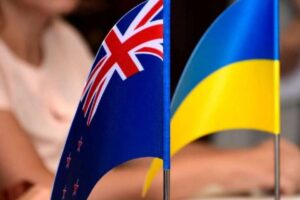
Australian Prime Minister Anthony Albanese announced another package of military support to Ukraine worth 110 million Australian dollars (about $74 million), local media reported.
The new package will include 70 pieces of equipment, including 28 M113 armored vehicles, 14 special-purpose vehicles, 28 MAN 40M medium trucks and 14 trailers.
Kiev will also receive a significant supply of 105mm artillery shells.
In addition, Canberra will provide 10 million Australian dollars to the United Nations to meet Ukraine’s humanitarian needs.
The prime minister stressed that Australia would support Ukraine for as long as necessary.

Ukraine has received about 90,000 tons of in-kind aid, such as equipment and medicines, through the EU Civil Protection Mechanism since the start of the Russian invasion, DW reported.
“This is by far the most complex, the most extensive and the longest operation under the EU Civil Protection Mechanism in the history of its existence,” said European Commissioner for Crisis Management Janez Lenarčič, quoted by the newspaper.
He said assistance was provided with food, medicine, vehicles, generators, transformers and equipment to repair power grids and other critical infrastructure.
“We even delivered items such as sunflower seeds and equipment to protect cultural monuments,” Lenarcic said.
In addition, more than two thousand patients and wounded from Ukraine have been treated in more than 20 EU countries, the commissioner added.
Ukraine officially joined the EU Civil Protection Mechanism on April 20, 2023. Within the framework of this mechanism, the EU states and other countries cooperate in preparedness and response to crises and disasters.
Thanks to the Mechanism, Ukraine has received assistance before, just like any other country in the world following a request. As a member of the Mechanism, Ukraine will have access to expert exchanges, training programs and exercises, and will be able to provide assistance to countries in crisis.

Ukraine’s First Deputy Foreign Minister Emine Japarova will visit New Delhi next week to discuss, among other things, providing additional humanitarian aid, The Hindu reported, citing diplomatic sources.
“Ukraine has requested additional humanitarian aid from India, including pharmaceuticals, medical equipment and energy equipment to repair energy infrastructure damaged during the war, and both sides are expected to discuss providing such support,” the report said.
Japarova is also expected to extend an invitation to Indian Prime Minister Narendra Modi to visit Kiev.
Diplomatic sources said final arrangements are still being discussed, but confirmed that Emine Japarova, the first deputy foreign minister, is expected to arrive in Delhi on Monday and hold an interagency dialogue and meet with media and think tanks in the capital to enlist Ukraine’s support in India,” the report noted.

Estonian Defense Minister Hanno Pevkur, who arrived in Kyiv on a visit, expressed words of support for Ukraine and announced another aid package, including the Role 2 mobile field hospital, the Ukrainian Defense Ministry said.
Pevkur assured that Estonia will help Ukraine win this war. He also announced another package of assistance to Ukraine, which will include important things for the Armed Forces of Ukraine, according to his statement, cited by the Ukrainian Defense Ministry.
The Minister of Defense of Estonia said the new assistance package includes the Role 2 mobile field hospital, which will save the lives of Ukrainian defenders at the frontline. The symbolic key to the third hospital, transferred to Ukraine by Estonia, the Netherlands and Norway, Pevkur handed over to Minister of Defense of Ukraine Oleksiy Reznikov, the press service of the Ukrainian defense ministry said.
As Pevkur noted, the total amount of assistance to Ukraine from Estonia has already exceeded 1% of the GDP of this Baltic country. That is why the head of the Estonian Ministry of Defense called on other Western countries to follow the example of his country and increase assistance to Ukraine.
Pevkur said that recently, at the level of the countries of the European Union, Estonia initiated urgent support for the Ukrainian defense with one million 155-caliber artillery shells. It is going to do everything so that Ukraine receives more ammunition, equipment, equipment and other necessary assistance, he said.
According to the Defense Ministry press service, representatives of the Estonian defense department were presented with the logistics program LOGFAS – a system for recording, controlling the movement and end use of military equipment and property received from Western partners.
At the meeting, the defense ministers of the two countries discussed the issue of further consolidation of efforts to repel Russia’s armed aggression and the implementation of bilateral projects to strengthen the capabilities of the Ukrainian defense forces.

Ukraine and Saudi Arabia signed documents on Sunday in Kiev to provide Kiev with a $400 million aid package, $100 million in humanitarian aid and $300 million in oil products, Ukrainian President Andrei Yermak said in his Telegram channel.
“There is a successful visit to Kiev of the Foreign Minister of Saudi Arabia, Prince Faisal bin Farhan Al Saud. He met with President Vladimir Zelensky and the team. This is the first official visit of the Minister of Foreign Affairs of Saudi Arabia to Ukraine since the establishment of diplomatic relations between our countries (14 April 1993). And I am personally grateful to Prince Feisal bin Farhan Al Saud for the constructive dialogue that eventually led us to this meeting,” he wrote.
In particular, Yermak also wrote, “we are talking about a joint cooperation program with the King Salman Center for Humanitarian Aid and Relief and a Memorandum of Understanding with the Saudi Development Fund.”
“I would like to remind you that Ukraine and Saudi Arabia have common challenges and experience in dealing with them. We are talking about Iranian UAVs, which were supplied to certain ‘insurgents’ and carried out attacks on Saudi oil facilities,” he also wrote.
Yermak reminded that “starting last year, the same Iranian UAVs ended up with Russian terrorists and carry out attacks on the Ukrainian energy infrastructure. Therefore, we also share experience in fighting terrorists.

The Canadian Mint has decided to direct the net proceeds from the sale of its annual Pysanka 2023 gold and silver coin issue to humanitarian aid for Ukraine.
“Your Fine Silver Pysanka 2023 is designed in a Tripolitan artistic style based on the drawings of prehistoric earthenware and executed in natural colors,” the description of the silver coin notes.
“And on the 99.99% pure gold gold peeing coin, the beloved floral emblem of the Ukrainian people (sunflower) is surrounded by symbols that celebrate the return of the sun, and with it the arrival of spring,” the Mint of Canada pointed out.
Coins in the traditional pysanka form were issued in 7,500 and 275 pieces, respectively, and at a face value of CAD 20 and CAD 250 respectively, and were offered at CAD 139.95 and CAD 6999.95.
“Yesterday the Royal Canadian Mint released an incredibly beautiful coin depicting a Ukrainian pysanka… The entire collection, which is 7500 coins, was completely sold out for the day”, – said, in turn, the Ukrainian Ambassador Yulia Kovaliv.
The total amount of coins sold at declared value – 2.97 million Canadian dollars (about $ 2.23 million at current exchange rate) at a total denomination of $ 0.150 million Canadian dollars.